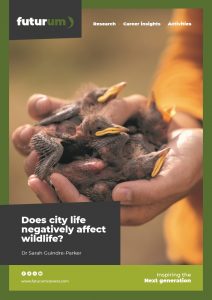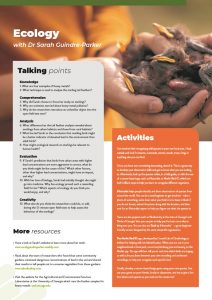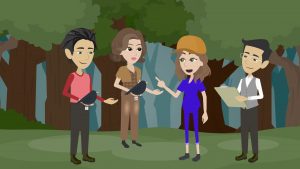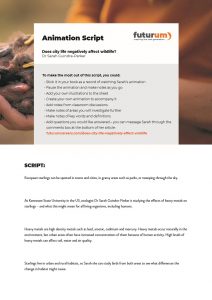Does city life negatively affect wildlife?
If you have ever seen the beautiful sight of hundreds of starlings sweeping through the sky in unison, you will know how at ease these birds look in their environment, even in an urban setting. Starlings seem to have adapted well to cities, but how healthy is this for them? At Kennesaw State University in the US, Dr Sarah Guindre-Parker is an ecologist investigating the effects of urban life on starlings – and the implications for us all.
Talk like an ecologist
Biomonitoring tool — an indicator species that can be used to assess the health of an environment
Heavy metal — a high density metal that can cause health problems
Mass spectrometry — a laboratory technique used to identify chemical substances
Lead-based paint — any industrial or household paint that contains the metal lead. It can be highly toxic, especially to children
Nestling — the name for a baby bird which has not yet left its nest
Ornithology — the study of birds
Physiology — the scientific study of the way that an organism functions
Trace element — a chemical element only present in tiny amounts
Urbanisation — the increasing number of people moving to and living in urban areas, i.e., towns and cities
If you are familiar with starlings, it might be because when they flock together, their flight creates swooping aerial patterns in the sky. These glossy, dark birds can often be spotted in towns and cities. They eat worms, spiders, caterpillars and insects, which they find on short grassy areas such as garden lawns, sports fields and parks. Overflowing rubbish bins and household waste in flimsy, plastic bags also provide starlings with easy meals.
At Kennesaw State University, ecologist Dr Sarah Guindre-Parker is studying these birds to see how their tendencies for city life might affect them – and what this might mean for all living organisms, including humans.
What are heavy metals?
Heavy metals are high density metals such as lead, arsenic, cadmium and mercury. While heavy metals do occur naturally in the environment, urban areas often have increased concentrations of them because of human activity. “Heavy metals can be released into the environment in diverse ways, ranging from mining to metal corrosion to agricultural fertilisers,” explains Sarah. High levels of these metals can affect an area’s soil, water and air quality, resulting in negative health effects for people and wildlife.
“Heavy metals can persist in homes or in the environment for long periods of time, often undetected, which is why scientists are concerned about heavy metal pollution,” says Sarah. Heavy metals have also been added to common, everyday items, such as paint. Although lead-based paint was banned from use on houses in the US in 1978, older houses are still likely to contain lead-based paint, which can have serious implications for human health.
How do starlings come into this?
When Sarah decided to study the effects of these metals on birds, she knew starlings would be a great species to focus on. “European starlings or common starlings (Sturnus vulgaris) are a common species that is known as an ‘urban-adapter’ species,” explains Sarah. “This means that they can be found in urban habitats, as well as more rural habitats.”
As a result of this tendency, Sarah’s team can study starlings from both urban and rural areas to see what differences the change in habitat might cause. Another useful aspect of starling behaviour is that while they will often nest in cavities and vents in buildings, they will also lay their eggs in nest-boxes. Compared to the more particular nesting habits of other bird species, the starlings’ behaviour makes Sarah’s work easier, as she can put out nest-boxes and begin monitoring the starlings immediately – without having to find hidden breeding sites.
What does studying starlings involve?
Sarah is based in the US state of Georgia, and, so far, alongside the rest of her team, she has sampled over 300 starlings across 11 different sites in the metro-Atlanta area, the most populous area in the state. The team samples starlings on various properties, ranging from busy, urban parks – such as the city’s well-known Piedmont Park – to rural, private farms.
“Typically, we head out in the early morning, set out big bird traps and place bird food inside the traps,” says Sarah. “There are small tunnels through which the starlings can walk in but then can’t find their way out of easily.” These traps catch the birds but do not harm them. The researchers can then carefully attach a metal band with a unique reference number onto a bird’s leg. This allows them to know when and where they saw the starling, and prevents them from accidentally analysing the same bird again.
The team then collects a tail feather before conducting an ‘open field test’. This involves placing the starling in a small, enclosed tent and filming it for 12 minutes, during which time an unfamiliar object is shown to the bird.
What happens next?
Sarah and her team watch the 12-minute open field test videos to gather detailed insights into the behaviour of each bird. These videos show how confident different birds are in new environments (by how much of their time is spent exploring the new space compared to hiding) and how aggressive they are (by how they treat or attack the unfamiliar object).
Secondly, the collected tail feathers are washed and sent to the University of Georgia’s Agricultural and Environmental Services Laboratories to be analysed for heavy metal concentrations. The laboratories use an advanced chemical technique called mass spectrometry to measure the precise concentration of any trace elements of heavy metals in the feathers. Combining the results of these two data sources, the team can see if birds with higher heavy metal concentrations in their feathers behave differently.
What has the team found?
Sarah’s team is still analysing the test videos, gathering data and collating its results. “We might predict that birds with higher lead contents in their feathers would be more aggressive and more likely to attack the new object in the tent,” explains Sarah.
The tail feather analysis has shown that nestlings from urban habitats have higher lead concentrations in their feathers than nestlings from rural habitats. Interestingly, there is not a difference between lead concentrations in rural and urban adult starlings. “This tells us that nestling birds, rather than adults, may be a better indicator of elevated lead in urban environments. If we wanted to pick starlings as a biomonitoring tool to identify which urban habitats have high lead, we would want to use nestlings and not adults,” explains Sarah.
Reference
https://doi.org/10.33424/FUTURUM440
All photos © Jason Getz / Kennesaw State University
The team is yet to fully understand how these increased lead levels might affect starlings. However, a study on mockingbirds (a bird species found in the Americas) from researchers at Tulane University discovered that urban mockingbirds with elevated lead in their tissues behaved more aggressively. “This is a great study, with the researchers suggesting that being overly aggressive could be negative for the birds, because it could be a waste of their energy, lower their survival, or increase human-wildlife conflict,” explains Sarah. Covering a larger geographical scale and looking at a species of bird found all over the world, Sarah’s research will add to these findings, providing further insights into this field of study.
Where might this research go next?
Sarah is also interested in how her research might be applied to humans. For example, the results from another study which researched heavy metal concentrations in soil ended up helping local communities to know which gardens were safe to grow vegetables in, and which were not. Keep an eye out to see where Sarah’s work might end up taking her to.
 Dr Sarah Guindre-Parker
Dr Sarah Guindre-Parker
Department of Ecology, Evolution and Organismal Biology, Kennesaw State University, Georgia, USA
Field of research: Ecology
Research project: Toxicity in the city: the cumulative effects of heavy metals on the behaviour and physiology of urban-adapted birds
Funder: US National Science Foundation (NSF)
About ecology
The scope of ecology is massive, as it includes studying any process or organism that occurs in the natural world, as well as how these organisms interact with each other and their environment.
Humans rely on and are affected by the natural world. Equally, human activity impacts the natural world. Urbanisation (which sees humanmade infrastructure encroaching on the natural world) and pollution have a huge impact on organisms and the environments they live – or used to live – in. As climate change continues to impact our world, pushing species out of their regular habitats into new areas and changing air and water temperatures across the globe, ecologists have a huge number of important questions to answer.
Ecology is fascinatingly interconnected, as research on one species is often relevant to other species as well. “The findings of research on heavy metals in birds, for example, might be applied to benefit humans by using bird samples to map where dangerous hotspots of heavy metals occur,” explains Sarah. “This could lead to initiatives to remove heavy metals from the environment.”
What research opportunities will be open to the next generation of ecologists?
Sarah says, “It is important to understand how human activities are impacting not only wildlife but humans themselves. Environmental scientists, ecologists, city planners, government officials and conservation biologists will all need to work together to study the issue of urbanisation and find ways to minimise the negative impacts of building large cities.”
Pathway from school to ecology
• At high school and post-16, take classes in biology and geography. “Ecology can also benefit from topics in chemistry and, even, physics,” says Sarah.
• Outside of school, try to volunteer with a botanical garden, community garden, or a local ornithology group.
• Study an undergraduate degree in ecology, environmental science, physical geography or biology. You will then need to complete a master’s degree if you want to work in scientific research. Many researchers also complete a PhD, although this is not always the case. Sarah explains, “In the US, many ecology jobs in private sectors do not require a PhD, but becoming a scientific team leader in the field usually does.”
• Aim to get some hands-on research experience as soon as possible. “If you are interested in becoming a researcher in the field of ecology, you should test out whether you really like it early on by getting research experience in an ecology lab,” says Sarah. “Whether you are attending high school or are already in college or university, contact a professor who conducts research that you are interested in helping with. Sometimes, there can even be remote options to participate in from afar. Some positions are paid and others are voluntary; it is always worth sending an email to ask about what opportunities might be available.”
Explore careers in ecology
• Have a look at Environmental Science for some great information on how to become an ecologist and what an ecologist typically does.
• “One of my favourite job boards for ecology opportunities is run by the Ecological Society of America,” says Sarah.
• Ecologists can work in academia, for private companies, or on environmental estates. As an ecologist, you can expect to spend a lot of time out in nature, collecting samples, and at the computer, handling big datasets and analysing how different species fit together and affect one another.
• “If you are interested in bird ecology research more specifically, my favourite website is the Ornithology Exchange job board. Here, you can find bird-specific volunteer or paid opportunities, as well as graduate position openings if you wish to get a master’s or PhD degree in bird ecology,” Sarah adds.
• According to Payscale.com the average annual salary for an ecologist in the US is around $55,000.
Meet Sarah
Who or what inspired you to become a scientist?
I always loved biology in school and, without really knowing what else to do with that, I planned to go to medical school. One year, I was looking for related work to do over the summer holiday and found a research assistant position that focused on the physiology of birds. I thought this would be good experience for my medical school applications… until I held my first bird. I fell in love with the intriguing little creature I was looking at close up. That summer job changed the course of my life; I realised we can learn things from animals that can help humans too. The way the environment impacts birds is not dissimilar to how it impacts human health and physiology.
What experiences have shaped your career as a scientist?
I was a research assistant for Dr Sophie Bourgeon (who is now at the Arctic University of Norway) when she was a postdoctoral researcher. She was a fantastic mentor. She taught me so much about studying birds but also about how to cope with a tough day in the field and how to laugh when things go wrong. She was incredibly patient, kind and encouraging. I feel very lucky that my first research job was in such a supportive environment where I could ask questions and learn so much. It made me want to be a great mentor for future students too.
What are your proudest career achievements so far?
My proudest achievement is seeing the students I have worked with and mentored go on and be successful. I am always so happy when I can write a recommendation letter for someone, and they later let me know they got the role that they were applying for. It is the best part of my job as a professor. Secondly, I am really proud when a student, researcher or professor uses my scientific papers in their classes or to shape their research. Every paper takes a long time to write and publish, so it feels great when it can be useful to someone else, especially the next generation of ecologists.
What are your ambitions for the future?
My aim for the future of my research is to produce findings that benefit local communities more directly. While I find it fascinating to study birds for the sake of it, I want to make sure the results of my research can be applied to benefit humans. Not only is this the mission of the US National Science Foundation, which is funding this work, but it is also a personal goal of mine to make the world better for future generations, including my daughter.
Sarah’s top tip
It is never too late to change your mind about what path you are pursuing. I changed my mind about my career path, and it was a great decision! I’ve worked with many students who felt they were discovering their passion too late, and they are all accomplishing great things in their new field of expertise now. I think it is easy to assume everyone figures out their path early on in life, but that isn’t the case.
Do you have a question for Sarah?
Write it in the comments box below and Sarah will get back to you. (Remember, researchers are very busy people, so you may have to wait a few days.)












I will like to know more about the results with humans. Have you herd of Karl Kosik? he talks about the totality and how we are part of the socio-eco ambient